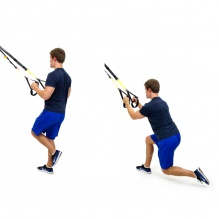
TRX, or Total Resistance eXercise, is a method of suspension training using your body weight and gravity to safely build strength and flexibility. TRX is a helpful addition to many physical therapy regimes because it allows weaker or older patients to regain strength without any heavy weights or balance concerns. It is also useful to help athletes build strength and endurance. In fact, TRX is an excellent all-ages method for stretching, strengthening and stabilizing. Summit Orthopedics uses TRX to help patients in the greater Minneapolis/St. Paul area.
A highly adaptable technique, TRX can be used both for unloading and stabilizing, a benefit for the older population, and for super loading and destabilizing, an approach for the athletic population. In just one example, when a person attempting to build strength attempts a squat, TRX allows then to split the weight between their upper and lower body, making it much more doable.
How TRX Works
TRX was created by Randy Hetrick, a Navy Seal deployed in Asia without access to a gym. He used webbing to create Y-shaped straps that allowed him to do basic exercises. After years of refinement, Hetrick’s TRX suspension trainer is now a simple but versatile tool that can be used by diverse patients with different needs.

A TRX system is mounted to the wall or another stable object, and two straps with handles are connected in a V-shape to an anchor strap. You can stand straight and pull on the straps for a rowing effect, or you can try exercises like planks, push-ups and squats. TRX provides resistance using your body weight, which creates the workout. If you adjust the angle of your body, exercises can be made harder or easier.
Benefits of TRX
TRX offers several benefits for different types of patients, as total body resistance helps you simultaneously engage muscles in your upper body, lower body and core. Physical improvements that may happen with TRX training include:
- Better balance. The straps can also provide assistance if balance is poor.
- Increased flexibility. When a patient can partly unload an exercise, they may be able to perform the exercise through a larger range of motion.
- Improved core strength. Fighting to keep a neutral spine with exercises increases activation of the core with every exercise.
- Stronger muscles. Patients can build strength starting at any level, using TRX to either support or challenge them.
For patients hoping to improve their overall fitness in addition to rehabilitation, TRX may help improve endurance and cardiovascular health.
Conditions Treated With TRX
Some research studies have suggested TRX may be a helpful part of physical therapy for many conditions and injuries, including:
- ACL tears
- Age-related muscle loss
- Ankle instability
- Balance and coordination difficulties after brain injury
- Lower back pain
- Shoulder instability
TRX may also help prevent injuries in athletes and others.
Who Can Use TRX?
One of the great things about TRX is that it can be used by just about anyone, from adolescents with sports injuries to older adults with balance problems. If you are physically able to tolerate body weight exercises and you want to work on coordination or full-body strengthening, you are a candidate for TRX.
Uses of TRX
When used one way, TRX can offload weight, similar to how you do when leaning on a table. If you have issues with balance or muscle weakness, or you have an injury that you can’t put your full weight on, suspension training allows you to use the straps to absorb the load of your body weight and stabilize your balance. For example, if you could never bend over and pick up a barbell, much less squat with one, the TRX system allows you to safely squat holding onto the handles of the strap.
The angle of your body while squatting—whether you go straight up and down, lean forward or lean back—adjusts the body weight you resist as you squat. Mild adjustments in your posture can make a big difference in how easy or hard the exercise is. As you build strength, your therapist can easily modify your program to make it more challenging. This flexibility makes TRX great for athletes and active adults who want to improve their performance and conditioning.
Suspension trainers can also create positions of instability, which pushes your muscles to work harder and boosts strength and endurance.
Training for TRX
Summit Orthopedics physical therapists who use TRX with patients have undergone specific training to utilize the benefits of suspension training for injury rehabilitation and other PT applications. This TRX training differs from the kind personal trainers at a gym may have received. Although strengthening muscles is often a goal of physical therapy, we use TRX in a different way than trainers who are solely focused on strength and performance. We aim to get you back to the activities you love with less pain or mobility problems.
Find a Summit Orthopedics physical therapist who specializes in TRX
